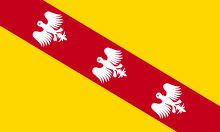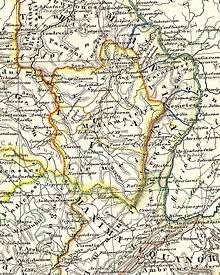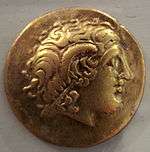Mediomatrici
| Part of the series on |
| Lorraine |
|---|
 Flag of Lorraine since the 13th century |
|
|
Administrative divisions
|
|
Lorraine in the EU |
|
Related topics |
|

The Mediomatrici (Greek: Μεδιομάτρικες[1]) were an ancient Celtic people of Gaul, who belong to the division of Belgae. Julius Caesar shows their position in a general way when he says that the Rhine flows along the territories of the Sequani, Mediomatrici, Triboci or Tribocci, and Treviri.[2] Ptolemy places the Mediomatrici south of the Treviri.

Divodurum (modern Metz, France) was the capital of the Mediomatrici. Besides Metz, settlements in France include the oppidum of Hérapel (today part of Cocheren), and the well-preserved examples of Pierrevillers and Vitry-sur-Orne. Other settlements and oppida in Germany were thought to be Saarbrücken (Roman Saravus), Speyer (Noviomagus), Homburg, and Rodalben, although today the ascription of Speyer, Homburg und Rodalben is hotly disputed.
The name "Mediomatrici" has been explained as "the people between the Matrona (Marne) and the Matra."[3] The diocese of Metz represents their territory, which was accordingly west of the Vosges, but Caesar makes the Mediomatrici extend to the Rhine, and consequently in his time they occupied the country between the Vosges and the Rhine. This agrees with Strabo, who says that the Sequani and Mediomatrici inhabit the Rhine, among whom are settled the Triboci, a Germanic nation which had crossed over from their own country.[4] It appears then that part of the territory of the Mediomatrici had been occupied by Germans before Caesar's time; and that after Caesar's time the German tribes, Nemetes, Vangiones, and Caeracates occupied the Gallic side of the Rhine, north of the Triboci as far as Mainz, and that north of Mainz was the territory of the Treviri, we may infer that all these tribes were intruders on the original territory of the Mediomatrici.
Elements of the Mediomatrici may have settled near Novara, in northern Italy, where place-names allude to their presence, e.g., Mezzomerico (attested as Mediomadrigo in 980).[5]
References
- ↑ Ptolemy. Geographia. II:8 §12 on LacusCurtius.
- ↑ C. Julius Caesar. De Bello Gallico. IV:10.
- ↑ Mountain, Harry (1998). The Celtic Encyclopedia , Volume 1. Universal-Publishers. p. 194.
- ↑ Strabo (tr.Horace White) (1988). The Geography of Strabo IV:3. Harvard University Press. Retrieved October 23, 2016.
- ↑ Istituto Geografico de Agostini, Nomi d'Italia, ISBN 88-511-0983-4, p. 384
 This article incorporates text from a publication now in the public domain: Smith, William, ed. (1854–1857). "Belgae". Dictionary of Greek and Roman Geography. London: John Murray.
This article incorporates text from a publication now in the public domain: Smith, William, ed. (1854–1857). "Belgae". Dictionary of Greek and Roman Geography. London: John Murray.

